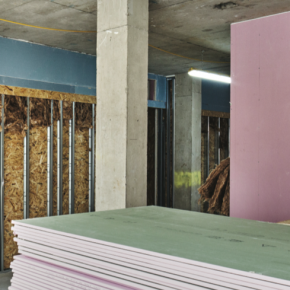
The productivity push: why small changes can unlock big efficiencies
Neil Ash, managing director of Etex Building Performance, discusses how targeted innovation and more collaborative working is vital to boosting the construction industry’s productivity, in the latest issue of ABC&D Magazine.

Neil Ash “Early engagement of materials providers and better communication between project partners must become the norm rather than the ideal”
Low productivity remains an issue for the UK economy. Only last month, data from the Office for National Statistics (ONS) showed that output per hour across all sectors fell by 0.1% in Q2 2017 following a 0.5% fall in the previous quarter, putting the UK behind the US, France, Germany and Italy.
Construction is no different. One year on from the Farmer Review of the UK construction labour model, the industry is still struggling to improve its efficiency and maximise current resources to meet development targets. The problem is complex and multi-faceted and we need a multi-pronged approach to solving it. As the Farmer Review identifies, closer collaboration across the supply chain, greater investment in innovation and technology, as well as new recruitment and training models must all form part of the answer.
However, the methods of delivering on these recommendations do not always need to be big ticket ones. Together, incremental strategic changes can add up to big savings.
The devil is in the detail
Major technical advances, such as greater use of modern methods of construction, undoubtedly have their part to play in solving the construction productivity puzzle. There are also some simpler, more readily achievable changes that we can make to the design and build process to accelerate project delivery.
Take the dry lining sector as a key example. As the main component of walls, ceilings, partitions and even external facade systems, dry lining materials and their ease of handling and installation account for a significant proportion of the build schedule. Etex Building Performance has been working with the Building Research Establishment (BRE) to assess the speed of installation for different dry construction systems, concentrating in particular on multi-residential projects to help speed-up housing delivery. What we found is that preparation works, such as moving materials around on site measuring and cutting boards, account for up to one-third of wasted or non-value added time.
To address these issues, Etex’s Innovation Team is now looking at developing pre-fabricated design details and making boards quicker to cut or easier to handle. It sounds simple but it is having the right knowledge that is key and knowing where and how to invest. Materials providers have to commit the necessary resources to this. There is the potential for big efficiencies to be achieved when the potential time savings are multiplied across an entire development. In the case of the dry construction sector, the benefits hold true whether new and improved materials are used on site or as part of off-site manufacturing systems.
Better together
The entire supply chain must continue assessing its ways
of working and honing processes if we are to boost construction’s efficiency. What will really help to amplify this work, however, is true collaborative working across the sector.
Our work with the BRE has highlighted the benefits that can be achieved from targeted innovation by materials providers. However, the wider supply chain can only benefit from this investment and knowledge if they engage them early on in
a project’s lifecycle, when the design can still be influenced. Yet, according to a survey by the National Building Specification (NBS), only 57% of designers and specifiers
seek the advice of manufacturers. This leaves a sizeable portion of the sector that is not capitalising on such expertise.
New technologies, like BIM, are helping us to realise the ambition for greater knowledge sharing but we cannot afford to overlook the simple behavioural changes that need to accompany digital innovations. Early engagement of materials providers and better communication between project partners must become the norm rather than the ideal.
Wider benefits
Our industry needs to work together to solve the productivity challenge. Strategic innovation by materials providers and knowledge sharing through more collaborative partnerships will ensure that the benefits of this investment and expertise is cascaded across the supply chain. The potential benefits for the construction sector are far-reaching; helping to improve industry margins as clients, contractors and their supply chain can move on more quickly to their next projects, and even supporting efforts to tackle the skills gap by driving a more efficient approach to labour resources. We need to keep an eye on the big picture’s goal, but that doesn’t mean we should overlook the detail in the process.
Latest news

17th April 2025
Nuaire shares expertise at Specifi Mechanical Services events in 2025
Indoor air quality and ventilation manufacturing specialist Nuaire is pleased to be exhibiting at the Specifi Mechanical Services events once again in 2025.
Posted in Air Conditioning, Articles, Building Industry Events, Building Industry News, Building Products & Structures, Building Services, Exhibitions and Conferences, Facility Management & Building Services, Heating, Ventilation and Air Conditioning - HVAC, Restoration & Refurbishment, Retrofit & Renovation
15th April 2025
West Fraser: CaberDek earns top marks from Home Counties carpentry specialist
A specialist carpentry sub-contractor covering housing sites across a large swathe of the Home Counties has come to value CaberDek from the West Fraser range for a variety of reasons: not least because the high quality panel product doesn’t destroy his operatives’ electric saws!
Posted in Articles, Building Industry News, Building Products & Structures, Building Systems, Case Studies, Restoration & Refurbishment, Retrofit & Renovation, Roofs, Timber Buildings and Timber Products, Wooden products
15th April 2025
GEZE: The Role of Access Control Systems in Enhancing Building Safety
Jane Elvins, Specification and Business Development Manager at GEZE UK, delves into the role of access control systems in enhancing building safety…
Posted in Access Control & Door Entry Systems, Architectural Ironmongery, Articles, Building Industry News, Building Products & Structures, Building Services, Doors, Facility Management & Building Services, Health & Safety, Restoration & Refurbishment, Retrofit & Renovation, Security and Fire Protection
11th April 2025
Don’t Do a Dave! It’s Time to Lock FIT Show 2025 in Your Calendar!
It’s that time again – FIT Show is back! You could be forgiven for thinking there won’t be much new to see when FIT Show returns to the NEC from 29 April – 1 May. Wrong!
Posted in Articles, Building Industry Events, Building Industry News, Building Products & Structures, Building Services, Continuing Professional Development (CPD's), Exhibitions and Conferences, Information Technology, Innovations & New Products, Restoration & Refurbishment, Retrofit & Renovation, Seminars, Training
 Sign up:
Sign up: